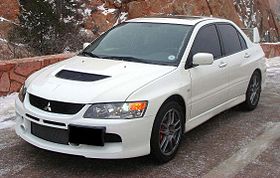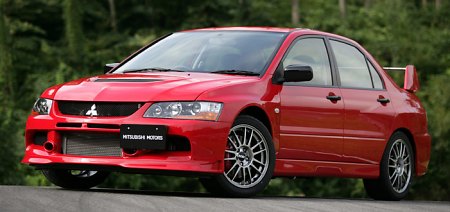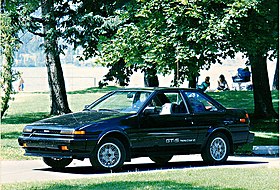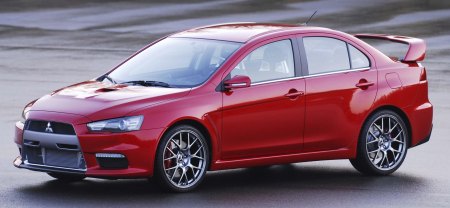Mitsubishi introduced the Lancer Evolution IX in Japan on March 3, 2005,
[15] and exhibited the car at the
Geneva Motor Show for the European market the same day.
[16] The North American markets saw the model exhibited at the
New York International Auto Show the following month.
[17] The 2.0 L
4G63 engine has
MIVEC technology (
variable valve timing),
and a revised turbocharger design boosting official power output at the
crankshaft to 291 PS (214 kW; 287 hp) and torque to 392 N·m
(289 lb·ft).

The USDM Lancer Evolution IX models: standard (Grand Sport Rally or
"GSR" in some markets), RS (Rally Sport), SE (Special Edition) and MR
(Mitsubishi Racing) varied slightly in their performance capabilities.
Subtleties unique to each model accounted for variations in
acceleration, handling and top speed. The RS excluded features standard
on the standard, SE and MR models (stereo system, power windows and
locks, rear wiper, rear wing, trunk lining and sound insulation). The
result is a weight savings of over 60 lb (27 kg). The fuel capacity
remains the same as the Evo VIII at 14 US gal (53 L).
Although the RS is the lightest of the group, the RS did not manage
to outperform the standard IX and the MR around a road course (even if
only by fractions of a second). This was purported to be due to the lack
of a rear wing on the RS. In a drag race, the three models are all
about even. They are all capable of 0-60 times between 4.2-4.5 seconds,
and can run quarter mile times ranging from 12.6 to 13.3 (12.7-13.0 USA
versions) seconds depending on the model/driver. The RS model was
produced for rally and racing teams who wanted a platform to build a
race car from. It is stripped of all the creature comforts, and other
upgrades that drive the price up for features that the race teams would
not require.
The IX MR retained the features of the Evolution VIII MR, like
Bilstein shocks, a 6-speed manual transmission, a rooftop vortex
generator, BBS forged wheels, HID xenon headlights, foglights, accessory
gauge package, "zero lift" kit, special badging and an aluminum roof.
All models continued to sport
Recaro bucket seats,
Brembo brakes and
Momo steering wheels. Additional revisions from 2005 included a closer gear ratio for the 5-speed
manual transmission,
new lighter Enkei wheels on non-MR models, a redesigned front end with a
more efficient air dam (the most noticeable feature are the two small
oval ducts to cool the intercooler pipes), and a new rear bumper with a
diffuser undersurface to smooth out the airflow coming out of the car
for non-US models. In an effort to reduce the price increase on the
Evolution IX model,
[citation needed]
HID headlights were no longer standard equipment on the base IX (nor
were they standard on the 2005 VIII), and were available only in the SSL
package (Sun, Sound, and Leather), SE (Special Edition) and MR trims.
The US versions of the Lancer Evolution IX did not come with the AYC
but the ACD was still present. The drivers can select from three
different driving modes, "Tarmac" "Gravel" and "Snow", and the car's
computer system relatively promotes the active center differential to
change the differential locking which, Despite popular belief, this
switch DOES NOT change the torque split. The differential is geared at
50:50 and cannot be changed by the push of a button. What this switch
actually does is quite simple. Each setting determines how long the ACD
will delay in freeing the center differential after a steering input is
made. In addition, it will determine how much locking force the ACD will
exhibit on the clutch pack and center differential.
Tarmac is the setting to be used in dry, paved conditions. In this
setting, the ACD will almost immediately allow the center differential
to go into a free state upon detecting a steering input. Additionally,
this mode provides the strongest limited-slip clamping force of the
three modes. Although the US versions did not come with the AYC, it did
come with a rear 1.5way clutch type LSD (limited slip
differential)which, limits the slip from both rear wheels causing less
traction loss of the rear wheels. The most common setup is the 1.5 way
LSD, locking on throttle and partially locking on braking. In racing,
Lancer Evolutions are not equipped with AYC or ACD because it is
believed that better lap times are achieved by pure driver skill without
any computer based assistance systems.
One of the changes from the previous iteration of the Lancer
Evolution, was the change in the engine, the new 4G63 came with MIVEC,
Mitsubishi's variable valve lifting technology, which drastically
improves the fuel consumption by changing the valve timing on the intake
cam. The MIVEC system is similar to Honda's i-VTEC system only that it
doesn't change valve lift, only intake valve timing.
Three trims were available for Japan, Asia and Europe. Although all
models used the same 291 PS (214 kW; 287 hp) engine, the torque differed
from one model to another. In Europe, however, the Evolution IX was
advertised to have 280 PS (206 kW; 276 hp). The GSR produced 400 N·m
(295 lb·ft) of torque, while the RS and GT produced 407 N·m (300 lb·ft).
- RS – "rally sport", revised 5-speed, aluminium roof, gauge
pack, minimal interior, LSD and a titanium-magnesium turbine, left-hand
drive option available.
- MR RS – same as RS with 6-speed Manual Transmission.
- GT – revised 5-speed, this is basically the RS mechanically, but with some of the GSR's features (mainly interior pieces).
- GSR – 5-speed, Bilstein
monotube shocks, aluminium roof, gauge pack, SAYC (Super Active Yaw
Control), and double-din radio (this is roughly equivalent to the USDM
MR).
- MR GSR – same as GSR with BBS 17-inch alloy wheels and 6-speed Manual Transmission.
- MR Tuned by RALLIART – Based on Lancer Evolution VI Tommi Makinen Edition, The Japanese Lancer Evolution IX was exclusively tuned by Mitsubishi Ralliart
features the almost same as the civilian Evo IX MR GSR except for
Carbon Fiber front lip Spoiler, Official Ralliart livery, Ralliart RA04
17-inch Black forged aluminum wheels.
In the United Kingdom, the Evolution IX used a different model scheme
based on the car's horsepower. There were initially three models
available: the FQ-300, FQ-320 and FQ-340 each with around 300(296/221),
320(316/236) and 340(336/250) PS(BHP/KW) respectively. An FQ-360 model
was subsequently released as a successor to the Evolution VIII FQ-400.
While the new FQ-360 produced less horsepower than its predecessor, it
had more torque at 363 lb·ft (492 N·m) at 3200 rpm. All four models were
designed to run on
super unleaded petrol only. The MR FQ-360 was also released in limited numbers (only 200) in the last year of production.
- FQ-300, 320, 340 – 6-speed, Bilstein monotube shocks, AYC (Active Yaw Control), super unleaded petrol only
- FQ-360 – 6-speed, Bilstein monotube shocks, AYC (Active Yaw Control), Ralliart Sports Meter Kit, carbon front splitter, Speedline alloy wheels, super unleaded petrol only
- MR FQ-360 – New turbo with titanium aluminium alloy turbo
fins, Speedline Turini alloy wheels, Privacy Glass, Lowered Eibach Coil
springs (10mm at the front/ 5mm at the rear), IX MR interior, super
unleaded petrol only
Four models were available in the US. All models used the same 286 hp (213 kW) engine.
- Standard – revised 5-speed, standard model
- RS – ralli sport, revised 5-speed, aluminum roof, gauge pack, minimal interior, also no radio
- SE – Special Edition, aluminum roof/hood, and front fenders,
split seven-spoke forged aluminum BBS wheels in "diamond black" finish,
HID headlights with integrated fog lights, red-stitched Recaro seats
- MR – 6-speed, Bilstein monotube shocks, split seven-spoke
forged aluminum BBS wheels, aluminum roof, hood, and front fenders,
gauge pack, HID headlights with integrated fog lights, vortex generator,
front brake cooling ducts and custom MR badging.
All of the American models are the same in power, but may differ in
performance. The only thing that sets them apart is the Evo RS, which is
80 lb (36 kg) lighter than the MR and SE models.
To the standard model, the Sun, Sound and Leather package added a
power sunroof, HID xenon headlamps with integrated fog lights, a
slightly different stereo headunit (with no integral amplifier),
slightly upgraded speakers in the front doors and parcel shelf, a
4.1-channel amplifier under the driver's seat, a powered, trunk-mounted
Infinity subwoofer, black leather seating surfaces, leather-trimmed door
panels, slightly revised center armrests in the front and rear, and
separate rear side headrests. This model deleted the GSR's
headliner-mounted sunglass holder to make room for the sunroof.

The Philippines had the Evolution IX until in August 2008, which was
offered in two trims, the entry-level RS offering a 5-speed manual
transmission,
Brembo 17-in. ventilated discs (4-Pot),
Brembo
16-in ventilated drum-in-disc (2-Pot) and almost the same features as
to that of the GSR trim in the international version. Some RS models had
the SAYC option, while some did not. The MR was the top-of-the-line
segment, which offered almost the same features as to that of the MR
trim in the international version. All of them are powered by the same
2.0 L I-4
4G63 turbocharged MIVEC engine.
Mitsubishi also released a rare Evolution IX wagon in GT, GT-A and MR
models. All variants had options for a 6 speed manual or a 5 speed
automatic. The automatic variant uses a non-MIVEC 4G63 with a smaller
turbo. It was only sold in Japan and imported to other countries as grey
imports. Only 2500 Wagons were produced
Evo IX (2005)
Another 2 years had passed
and the 9th generation
debuted in March 2005. This was also the last one built on the
contemporary Lancer platform and with the legendary 4G63 engine. The
latter gained MIVEC intake variable valve timing and, accompanied with
yet another fine tuning of the turbochargying system, produced slightly
more torque and a flatter torque curve. Like the previous MR, the roof
was made of aluminum – this made the new MR model less significant. The
rear spoiler was made of hollow carbon-fiber. Cosmetically, it
abandoned the previous corporate grille and returned to a no-nonsense
one. Aerodynamics was barely revised. The Evo IX was the least improved
generation of all.
| Overview |
|---|
| Production |
March 2005 – October 2007(August 2006-Late 2008 MR) |
| Body and chassis |
| Platform |
CT9A
CT9W |
| Powertrain |
| Transmission |
5-speed manual
6-speed manual
5-Speed Automatic (wagon) |
| Dimensions |
| Wheelbase |
2,625 mm (103.3 in) |
| Length |
4,490 mm (176.8 in) |
| Width |
1,770 mm (69.7 in) |
| Height |
1,450 mm (57.1 in) |
| Curb weight |
1,310–1,490 kg (2,888–3,285 lb) |






